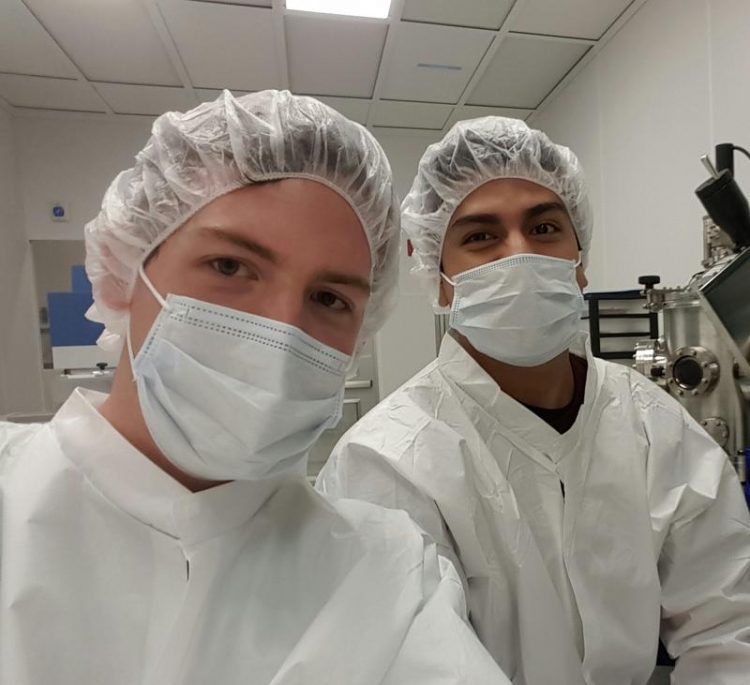Nanoquakes Probe New 2-Dimensional Material

UC Riverside student Edwin Preciado (right) and his University of Augsburg colleague Sebastian Hammer working in the cleanroom © Ludwig Bartels & Hubert Krenner
In a step towards a post-graphene era of new materials for electronic applications, an international team of researchers from the University of Augsburg (Germany) and the University of California, Riverside (USA) has found a new and exciting way to elucidate the properties of novel two-dimensional semiconductors. These materials have unique properties that promise better integration of optical communication with traditional silicon-based devices.
The researchers fabricated a single-atomic-layer-thin film of molybdenum disulfide (MoS2) on a substrate of lithium niobate (LiNbO3). LiNbO3 is used in many electronic devices dealing with high-frequency signals such as cell phones or radar installations.
Applying electrical pulses to LiNbO3, the researchers created very high frequency sound waves – “surface acoustic waves, SAWs” – that run along the surface of LiNbO3, akin to earthquake tremors on land. Cell phones, for example, use resonances of these surface waves to filter electric signals in a manner similar to a wine glass resonating when a voice hits it at exactly the right pitch.
The Augsburg group is renowned for their pioneering work on the application of nano-earthquakes on a chip in all areas of nanotechnology.
Specifically, the research team used the surface waves of LiNbO3 to listen to how the illumination of LiNbO3 by laser light changes the electric properties of MoS2.
“The tone at which a wine glass resonates changes as you fill it up. If you ping it with a spoon, you can hear that tone. With practice you can guess from the tone how full the wine glass is without looking at the glass,” explained Ludwig Bartels, a professor of chemistry who led the team at UC Riverside. “In a similar way, we can 'hear' the LiNbO3 sound waves and infer how much current the laser light allowed to flow in the MoS2. We also fabricated transistor structures onto the MoS2 films and proved that indeed our analysis is correct.”
Study results appeared online last week in Nature Communications.
“The well-established nature of the substrates and the processes to create surface acoustic waves makes the novel technique facile and ready to be applied,” Bartels said. “In particular, even remote, wireless sensing applications appear to be within reach.”
The research project resulted from collaboration between students and researchers at UC Riverside and the University of Augsburg, Germany.
For this project, the Bavarian-Californian team greatly benefited from the complementary expertise between the two universities, allowing the researchers to explore new perspectives. Material fabrication proceeded at UCR followed by device integration and experiments at University of Augsburg.
“It was really exciting to see how our students obtained these fascinating results by combining the 2D materials from California and our world-class expertise in surface acoustic waves,” said Hubert Krenner, a member of the Cluster of Excellence Nanosystems Initiative Munich (NIM), Germany, who led the project at the University of Augsburg together with SAW-Pioneer Achim Wixforth.
UCR graduate student Edwin Preciado and University of Augsburg recent graduate Florian J. R. Schülein spearheaded the research project in the research laboratories of Bartels and Krenner, respectively.
“International collaboration and my being able to do research work in Germany was crucial for the success of this project,” Preciado said. “I learned much by staying for a few months in Augsburg. It provided me with experience and skills that otherwise I would not have been able to acquire easily.”
Likewise, Sebastian Hammer, a graduate student at the University of Augsburg, worked in Bartels's lab this summer fabricating a new batch of devices in an extension of the current project.
The collaborative interaction was facilitated by generous support from the Bavaria-California Technology Center (BaCaTeC). The research was supported by C-SPIN, a STARnet center of the Semiconductor Research Corporation, the U.S. National Science Foundation, the Deutsche Forschungsgemeinschaft and the Nanosystems Initiative Munich (NIM).
Reference:
Edwin Preciado, Florian J.R. Schülein, Ariana E. Nguyen, David Barroso, Miguel Isarraraz, Gretel von Son, I-Hsi Lu, Wladislaw Michailow, Benjamin Möller, Velveth Klee, John Mann, Achim Wixforth, Ludwig Bartels, and Hubert J. Krenner: Scalable fabrication of a hybrid field-effect and acousto-electric device by direct growth of monolayer MoS2/LiNbO3; Nature Communications 6, 8593; doi:10.1038/ncomms9593 (2015); http://dx.doi.org/10.1038/ncomms9593
Contact:
Prof. Dr. Hubert Krenner
hubert.krenner@physik.uni-augsburg.de
Fon +49 821-598-3308
http://www.physik.uni-augsburg.de/de/lehrstuehle/exp1/emmynoether/
Prof. Dr. Achim Wixforth
achim.wixforth@physik.uni-augsburg.de
Fon +49 821-598-3308
http://www.physik.uni-augsburg.de/de/lehrstuehle/exp1/
Lehrstuhl für Experimentalphysik I
Universität Augsburg
Universitätsstraße 1
86159 Augsburg
Media Contact
All latest news from the category: Materials Sciences
Materials management deals with the research, development, manufacturing and processing of raw and industrial materials. Key aspects here are biological and medical issues, which play an increasingly important role in this field.
innovations-report offers in-depth articles related to the development and application of materials and the structure and properties of new materials.
Newest articles

NTU and NUS spin-off cutting-edge quantum control technology
AQSolotl’s quantum controller is designed to be adaptable, scalable and cost-efficient. Quantum technology jointly developed at Nanyang Technological University, Singapore (NTU Singapore) and National University of Singapore (NUS) has now…

How Geothermal Energy Shapes Bavaria’s Green Future Through Sustainable Energy
The Bavarian State Ministry of Science and the Arts has extended its funding for the research association “Geothermal Alliance Bavaria,” with the University of Bayreuth (UBT) continuing as a member…

Spintronics memory innovation: A new perpendicular magnetized film
Long gone are the days where all our data could fit on a two-megabyte floppy disk. In today’s information-based society, the increasing volume of information being handled demands that we…



